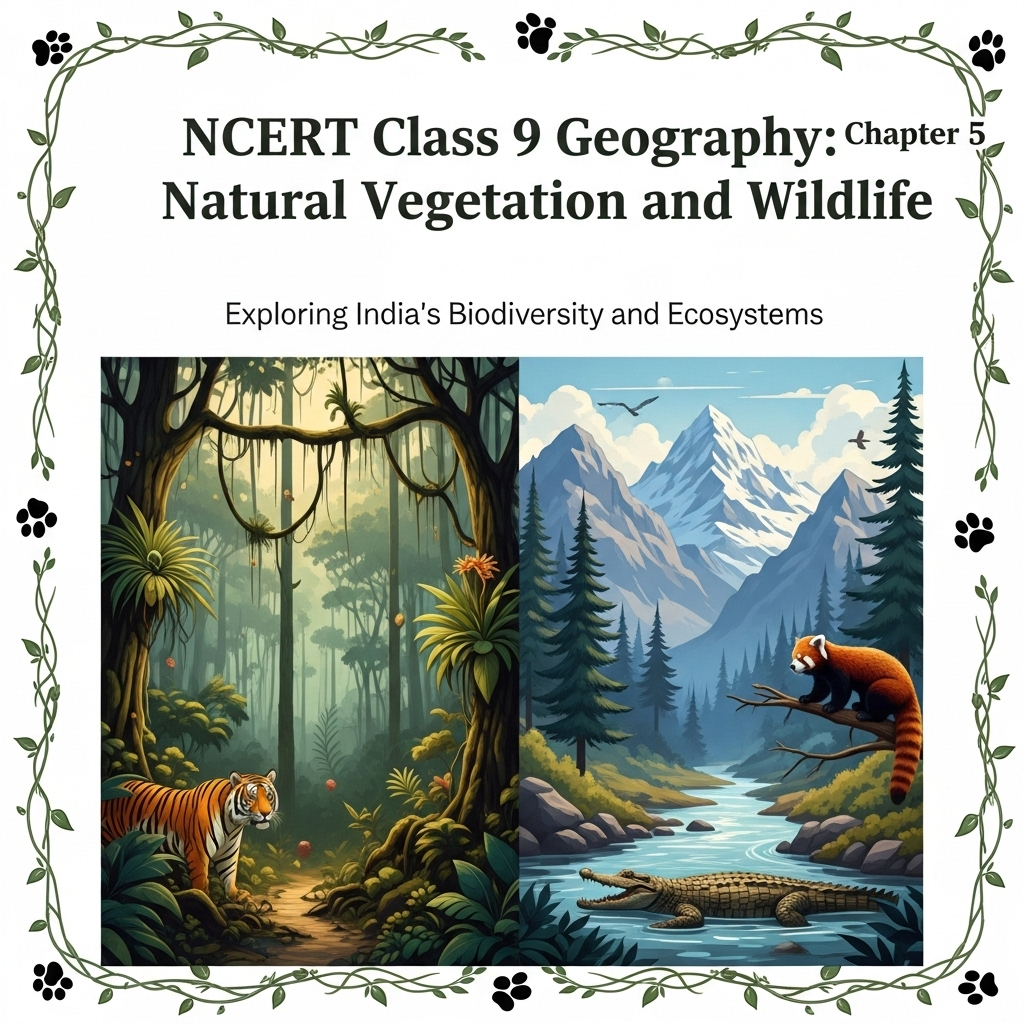Complete Solutions and Summary of Natural Vegetation and Wildlife – NCERT Class 9, Geography, Chapter 5 – Summary, Questions, Answers, Extra Questions
Detailed summary and explanation of Chapter 5 ‘Natural Vegetation and Wildlife’ covering the types of vegetation (evergreen, deciduous, thorn, montane, mangrove), forest and biodiversity zones, medicinal plants, endangered species, conservation efforts, and India’s wildlife heritage with all question answers, mapping skills, and extra questions from NCERT Class IX Geography.
Updated: 2 months ago
Categories: NCERT, Class IX, Geography, Summary, Extra Questions, Natural Vegetation, Wildlife, Biodiversity, Forest Types, Conservation, Chapter 5

Natural Vegetation and Wildlife
Chapter 5: Geography - Complete Study Guide | NCERT Class 9 Notes & Questions 2025
Comprehensive Chapter Summary - Natural Vegetation and Wildlife Class 9 NCERT
Overview
- Chapter Purpose: Explores variations in trees, bushes, grasses, birds around schools/parks, highlighting India's vast bio-forms. India as one of 12 mega biodiversity countries, with 47,000 plant species (10th world, 4th Asia), 15,000 flowering (6% world total), non-flowering like ferns/algae/fungi, 90,000 animals, rich fish variety. Natural vegetation: Plant community grown naturally without human aid, undisturbed long time (virgin vegetation). Cultivated crops/fruits/orchards part of vegetation but not natural. Endemic/indigenous: Purely Indian; exotic: From outside. Flora: Plants of region/period; fauna: Animals. Figure 5.1: Tropical Evergreen Forest. Key Insight: Biodiversity essential; conservation needed if plants/animals disappear—humans can't survive without. Reprint 2025-26 updates focus on threats like endangerment.
- Types of Vegetation: Major types (Figure 5.4): Tropical Evergreen, Deciduous, Thorn Forests/Scrubs, Montane, Mangrove. Factors: Rainfall, altitude, temperature influence distribution.
- Expanded Relevance 2025: Climate change impacts forests/wildlife; conservation via biosphere reserves. Update: Endangered species lists.
- Exam Tip: Distinguish forest types by rainfall/altitude; use Figure 5.4 for maps; know flora/fauna examples.
- Broader Implications: Vegetation/wildlife support ecosystems, medicines, economy; threats from hunting/pollution/habitat loss.
Tropical Evergreen Forests
- Characteristics: Restricted heavy rainfall (>200 cm, short dry season) in Western Ghats, Lakshadweep/Andaman-Nicobar islands, upper Assam/Tamil Nadu coast. Trees up to 60m, luxuriant multi-layered (trees/shrubs/creepers); no definite leaf-shedding, green year-round. Commercially: Ebony, mahogany, rosewood, rubber, cinchona. Animals: Elephant, monkey, lemur, deer, one-horned rhino (Assam/WB), birds, bats, sloth, scorpions, snails. Figure 5.1: Structure.
Tropical Deciduous Forests
- Characteristics: Most widespread (monsoon forests), rainfall 200-70 cm, shed leaves 6-8 weeks dry summer. Subdivided: Moist (200-100 cm, eastern: NE states, Himalayan foothills, Jharkhand, W Odisha/Chhattisgarh, E Western Ghats slopes; dominant: Teak, bamboos, sal, shisham, sandalwood, khair, kusum, arjun, mulberry); Dry (100-70 cm, Peninsular plateau rainier parts, Bihar/UP plains; teak, sal, peepal, neem; open stretches for cultivation/grazing). Animals: Lion, tiger, pig, deer, elephant, birds, lizards, snakes, tortoises. Figure 5.2: Tropical Deciduous Forest.
The Thorn Forests and Scrubs
- Characteristics: <70 cm rainfall, NW India (Gujarat, Rajasthan, MP, Chhattisgarh, UP, Haryana); thorny trees/bushes, scattered, long roots for moisture, succulent stems, small thick leaves minimize evaporation; acacias, palms, euphorbias, cacti. Animals: Rats, mice, rabbits, fox, wolf, tiger, lion, wild ass, horses, camels. Figure 5.3: Thorn Forests and Scrubs.
Montane Forests
- Characteristics: Mountainous, temperature decreases with altitude, succession tropical to tundra. Wet temperate (1000-2000m: Evergreen broad-leaf oaks/chestnuts); Temperate (1500-3000m: Coniferous pine, deodar, silver fir, spruce, cedar; S Himalayan slopes, high altitude S/NE India); Temperate grasslands higher; Alpine (>3600m: Silver fir, junipers, pines, birches; stunted near snow-line, merge shrubs/scrubs to Alpine grasslands for grazing by nomads like Gujjars/Bakarwals); Tundra: Mosses/lichens. Animals: Kashmir stag, spotted deer, wild sheep, jack rabbit, Tibetan antelope, yak, snow leopard, squirrels, shaggy horn wild ibex, bear, red panda, sheep/goats thick hair. Figure 5.5: Montane Forests.
Mangrove Forests
- Characteristics: Tidal coasts with mud/silt; dense mangroves, roots submerged; deltas Ganga, Mahanadi, Krishna, Godavari, Kaveri; sundari (durable timber), palm, coconut, keora, agar. Animals: Royal Bengal tiger, turtles, crocodiles, gharials, snakes. Figure 5.6: Mangrove Forests.
Wildlife
- Overview: India rich fauna: 90,000 species, 2000 birds (13% world), 2546 fish (12%), 5-8% amphibians/reptiles/mammals. Elephants (hot wet forests Assam/Karnataka/Kerala), one-horned rhinos (swampy Assam/WB), wild ass/camels (arid Rann Kachchh/Thar), Indian bison, nilgai, chousingha, gazelle, deer, monkeys. Only country with tigers/lions: Lions Gir (Gujarat), tigers MP/Sundarbans/Himalayas. Leopards prey animals. Rivers/lakes/coasts: Turtles, crocodiles, gharials (unique). Birds: Peacocks, pheasants, ducks, parakeets, cranes, pigeons. Himalayas: Yak, shaggy horn wild ox, Tibetan antelope, bharal, wild sheep, kiang, ibex, bear, snow-leopard, red panda. Figure 5.7: Wildlife Reserves. Wildlife Protection Act 1972. Role: Pollination, biological control; every species essential ecosystem.
- Medicinal Plants: India known herbs/spices ancient; 2000 Ayurveda plants, 500 regular use. Red List: 352 medicinal, 52 critically threatened, 49 endangered. Examples: Sarpagandha (blood pressure), Jamun (diabetes), Arjun (earache/blood pressure), Babool (eye sores/tonic), Neem (antibiotic/antibacterial), Tulsi (cough/cold), Kachnar (asthma/ulcers/digestive). Activity: Identify local medicinal plants.
Conservation and Threats
- Threats: 1300 plants endangered, 20 extinct; animals endangered/extinct from hunting, pollution, alien species, reckless cutting for cultivation/habitation. Newspaper clippings: Endangered tigers/rhinos/vultures. Activity: Find clippings, government steps, personal contribution.
- Measures: 18 biosphere reserves (e.g., Sundarbans, Nilgiri in world network); financial/technical aid botanical gardens (1992); Project Tiger/Rhino/Great Indian Bustard; 106 National Parks, 573 Wildlife Sanctuaries, Zoological gardens. Realize ecosystem importance; stop indiscriminate destruction. Figure 5.7: Reserves.
Migratory Birds
- Details: Wetlands attract migrants like Siberian Crane in winter. Rann Kachchh: Flamingos build nests salty mud, raise young. Rich natural heritage.
SEO Note: Why This Guide?
Top-ranked for 'Natural Vegetation and Wildlife Class 9 notes 2025'—free, with 60 Q&A from PDF, quizzes. Integrates biodiversity insights.
Key Themes
- Biodiversity Variations: Rainfall/altitude based.
- Details: Flora/fauna examples, maps (Figure 5.4). Activity: Why some states more forest cover?
- Conservation Links: Biospheres/projects for sustainability.
- Critical Thinking: Why biodiversity necessary? Impacts if lost.
Cases for Exams
Use Figure 5.4 for vegetation identification; discuss medicinal plants; analyze conservation objectives.
Exercises Summary
- Focus: Expanded to 60 Q&A from PDF: 20 short (2M), 20 medium (4M), 20 long (8M) based on NCERT exercises + similar.
- Project Idea: Poem/paragraph on wildlife; street play tree plantation; plant tree on birthday.
Group Discussions
No forum posts available.


